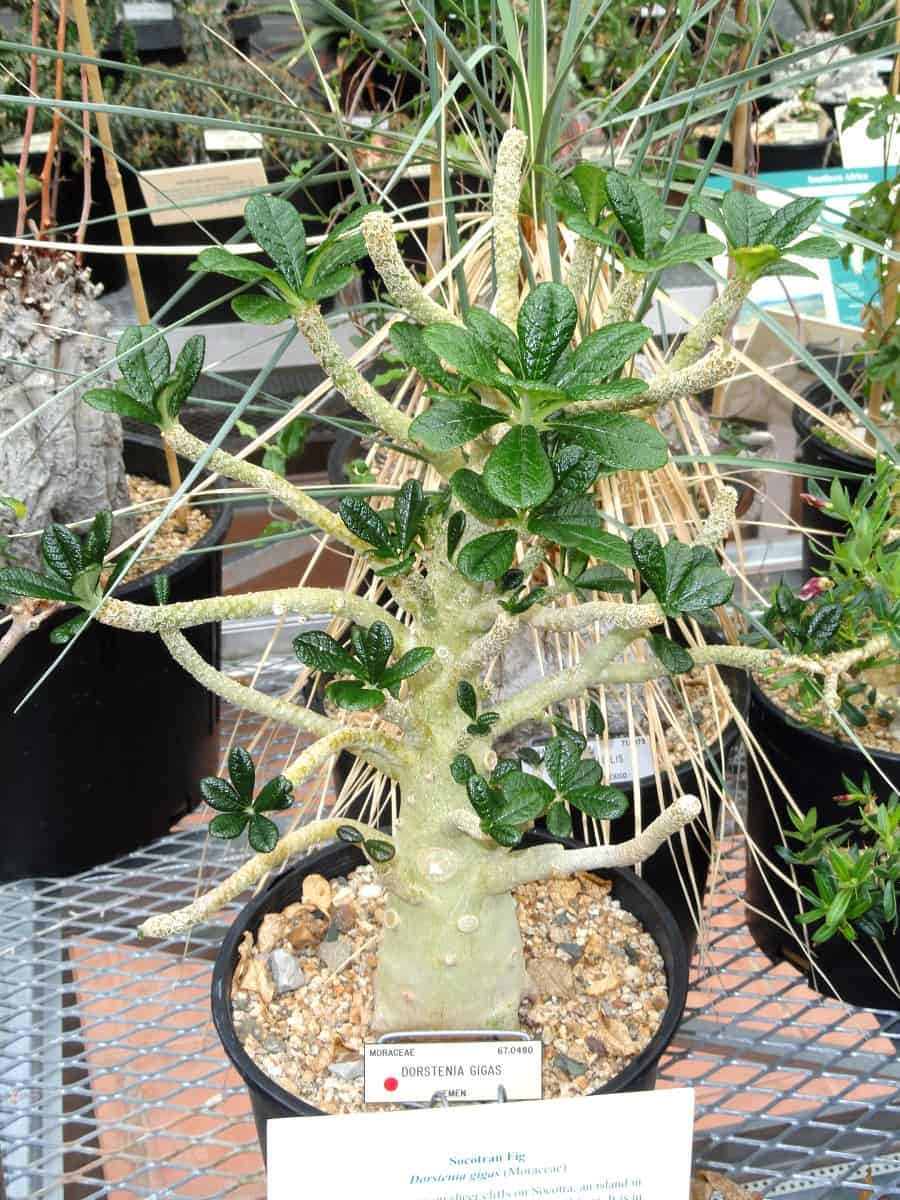Dorstenia gigas ‘Socotran Fig Tree’ is a shrub with a trunk that can reach up to 122 cm in height and approximately 101 cm in diameter.
The leaves of this plant are dark green and fleshy.
The flowers have star-shaped.
This is an interesting plant to have, especially in your garden.
Dorstenia gigas Care
Illumination:
This is a plant that requires semi-shade lighting with plenty of light, or full sun.
If you want to have it outside, place it where it receives 6 to 8 hours of direct sun, and the rest of the day is in semi-shade.
If, on the contrary, you want it inside your home, you have to put it in a well-lit place, so that the plant has an optimal development.
Substratum:
Like all succulents, these plants do not require a large substrate, with good drainage, and aeration is more than enough.
You can buy a specific substrate for cacti and succulents. Or you can improve a universal substrate or garden soil by adding vermiculite, perlite, and river sand to improve drainage.
You may like: Echinopsis chamaecereus
Watering:
Irrigation should be moderate in summer, somewhat scarcer the rest of the year.
Make sure the substrate dry completely before re-watering.
Remember that this is the great enemy of succulents. An excess of watering and humidity can cause the formation of fungi or rot of the plant.
So the substrate must have good drainage, and irrigation is moderate.
The best thing to do is wait until the soil is completely dry before watering the plant again.
Fertilizer:
You must fertilize your dorstenia gigas every 15 days with fertilizers for cacti and other succulents, following the instructions specified on the packaging.
The fertilizer should be applied only in spring and summer.
In cold seasons you should avoid adding fertilizers. What you can do is add some preventive fungicide to avoid the formation of fungi.
Propagation:
You can propagate dorstenia gigas by seeds (is difficult, due to the size they have), or by cuttings in spring-summer.
To multiply succulents by cutting follow these steps:
1. Detach a stem from the mother plant.
2. Remove the lower leaves of the cutting. Leave at least 2 inches uncovered.
3. Let the cut wound heal. Place it in a shady area. It will usually take at least 5 days to heal.
4. Sow cuttings in cactus and succulent substrate or make your own mix.
5. Water with spray in until the succulent is strong. Gradually reduce irrigation.
Temperature:
It is very sensitive to cold. The ideal minimum temperature is 15ºC/59°F.
If the temperature drops between 15ºC/59°F and 10 ºC/50°F, you should keep the soil or the substrate of the pots completely dry so they can withstand the cold and the low temperatures this way the roots won’t be affected.
Pruning:
Does not require pruning.
Plagues and diseases:
Like many others, this cactus is given to suffer fungal diseases, that is, fungal attacks, if they are watered excessively, and if the base substrate is kept moist.
Still, they are quite resistant to these attacks.
Transplant:
The most important thing when removing the succulent from the pot is not to pull it. If you do, you will end up breaking the roots and even the succulent.
If the succulent is in a plastic propagation pot, simply break the pot with scissors.
If the pot is not plastic, what you should do is insert a small stick through the drain hole and push the plant with the stick.
You can also cut some roots with scissors. Once you do this, tap the pot, and you’re done.
Once the succulent is out of the pot, keep pruning some damaged or severely bent roots.
Now it only remains to get a pot one or two inches larger than you had, and that’s it.
Do not plant your succulent in a pot larger than 2 inches from the previous size, as the plant will have more soil than it needs, and this can cause excess moisture, which is not good for succulents.
Conclusion
If you decide to grow this plant, believe me, you are not going to grow fast.
But if you have the patience, you have a beautiful, strange succulent.
